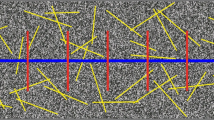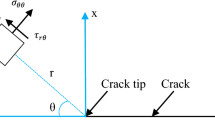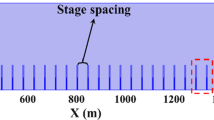Abstract
Shale gas reservoirs usually have extremely low porosity and permeability. By massive fracturing, shale gas industry development has well-developed fracture network, which generally has the characteristics of anisotropy and pressure sensitivity. Present studies on fracture network fail to consider both anisotropy and pressure sensitivity. The percolation experiments on pressure sensitivity, gas slippage effect, and water damage mechanism are carried out by a new physical experiment method with similar materials. It is not only more convenient but also more secure to use similar materials to observe fracture deformation and the flow law of fluid under low pressure. Then a new percolation mathematical model considering both anisotropy and pressure sensitivity is established. And a numerical solution of mathematical model with 19-point fully implicit finite difference is conducted. Finally, a discussion is presented of the results of numerical simulation and experiment test. The most significant finding is that (a) the gas slip effect has a greater influence on gas apparent permeability of fracture network media than pressure-sensitivity effect does; (b) the gas apparent permeability of fracture network media was affected greatly by fracturing fluid due to the formation damage and relative permeability; (c) the permeability of fracture network increases with initial formation pressure increases, decreases with well bottom pressure decreases; and (d) the anisotropic fracture network deformation will significantly decrease permeability, and the cumulative gas production is positively correlated with angle between main facture and horizontal well. The study will can play a significant role in the simulation of shale gas production.








Similar content being viewed by others
References
Buchsteiner H, Warpinski NR, Economides MJ (1993) Stress-induced permeability reduction in fissured reservoirs. Society of Petroleum Engineers. https://doi.org/10.2118/26513-MS
Celis C, Silva R, Ramones M, Da P G (1994) A new model for pressure transient analysis in stress sensitive naturally fractured reservoirs. Society of Petroleum Engineers. https://doi.org/10.2118/23668-PA
Du J, Wong RCK (2006) Coupled geomechanics—reservoir simulation of UTF phase a project using a full permeability tensor. Petroleum Society, Canadian Institute of Mining, Metallurgy & Petroleum, Paper 2007–152
Du J, Wong RCK (2010) Numerical modelling of geomechanical response of sandy-shale formation in oil sands reservoir during steam injection. J Can Pet Technol 49(1):23–28
Duan Y, Huang C, Chen W (2001) Pressure transient analysis for naturally fractured reservoirs with stress sensitivity. J SW Pet Inst 23(5):19–22
He J, Kang Y, Liu D et al (2005) The stress sensitivity research on porous and fractured porous carbonate reservoirs. Drill Prod Technol 28(2):84–86
Jiang H, Yan J, Li R (2000) Experimental study on stress-sensitivity of fracturing formations. Pet Dril Tech 28(6):32–33
Li C (2008) Stress sensitivity and productivity of fractured reservoirs. Xj Pet Geo 29(1):72–75
Ma S, Qibin Y, Wen S et al (2006) Evaluation on stress sensitivity of the low-permeability fractured reservoirs[J]. Pet Geo Rec Eff 13(5):88–90
Meza O, Gandulias VP, Nuñez CE (2010) Influence of stress field in the productivity of naturally fractured reservoirs in metamorphic basement: a case study of the San Pedro Field, Amotape Group. Society of Petroleum Engineers. https://doi.org/10.2118/138946-MS
Mina K, Rutqvist J, Tsang C (2004) Stress-dependent permeability of fractured rock masses: a numerical study. Int J Rock Mech Min Sci 41:1191–1210
Ning Z, Liao X, Gao W (2004) Pressure transient response in deep-seated geothermal stress-sensitive fissured composite gas reservoir. J Dq Pet Inst 28(2):34–36
Niu G, Lian P, Li L (2010) Well test analysis of reservoir with stress sensitive double porosity medium. Oil Gas Fiel Surf Eng 29(12):8–9
Roshan H, Rahman SS (2010) Analysis of stress and pore pressure in naturally fractured shale formations: a finite element based chemo-thermo-poroplastic model. Society of Petroleum Engineers. https://doi.org/10.2118/139104-MS
Tian J, Tong D (2006) The nonlinear flow simulation using double permeability model in deformed media. Eng Mech 23(7):40–44
Tong D (2001) Dynamic characteristics of reservoir with deformed double-porosity medium. Journal of the University of Petroleum, China 25(5):53–56
Tong D, Liu W, Xue L (2010) Flow characteristics of triple-permeability model in low permeability reservoir with deformed triple porosity medium. Chine Quart Mech 31(3):334–341
Wang Z, Yao J (2006) Study of pressure-transient characteristic for stress-sensitive triple-medium reservoirs with fractures and vugs conveying fluids to wellbore. J Hydrodyn 21(1):84–89
Wang R, Yue X, Zhao R et al (2009) Effect of stress sensitivity on displacement efficiency in CO2 flooding for fractured low permeability reservoirs. Pet Sci 6:277–283
Wong RCK, Du J (2003) Application of strain-induced permeability model in a coupled geomechanics-reservoir simulator. Petroleum Society, Canadian Institute of Mining, Metallurgy & Petroleum, Paper 2003–149
Wong RCK, Du J (2005) Development of a coupled geomechanics-thermal reservoir simulator using finite element method. Petroleum Society, Canadian Institute of Mining, Metallurgy & Petroleum, Paper 2005–027
Wong RCK, Du J (2006) Application of strain-induced permeability model in a coupled geomechanics-reservoir simulator. J Can Pet Technol 46(12):55–61
Wong RCK, Li Y (2001) A deformation-dependent model for permeability changes in oil sand due to shear dilation. J Can Pet Technol 40(8):37–44
Xiang Y, Xiang D, Huang D (2003) Study on the stress sensitivity of permeability in fracture-pore dual media by the full simulation experiment. Pet Geol Exp 25(5):498–504
Yang L, Tong D, Lin H (2006) The model and numerical simulation for deformed dual-porosity medium coupled with wellbore. J Oil Gas Tech(J.JPI) 30(6):103–106
Zhao D, Yao J, Wang Z (2005) The pressure transient characteristics of a stress sensitive triple medium reservoir. Chin J Comput Phys 22(5):444–448
Funding
This paper was financially supported by the National Natural Science Foundation Project of China (No. 51374222), National Major Project of China (No. 2016ZX05032005-002), and National Key Basic Research & Development Program of China (No. 2015CB2509005).
Author information
Authors and Affiliations
Corresponding author
Additional information
This article is part of the Topical Collection on Geo-Resources-Earth-Environmental Sciences
Rights and permissions
About this article
Cite this article
Mao, X., Liu, Y., Guan, W. et al. Experimental and numerical simulation on the influence of anisotropic fracture network deformation to shale gas percolation. Arab J Geosci 11, 615 (2018). https://doi.org/10.1007/s12517-018-3973-9
Received:
Accepted:
Published:
DOI: https://doi.org/10.1007/s12517-018-3973-9




